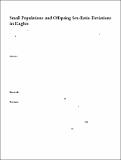Por favor, use este identificador para citar o enlazar a este item:
http://hdl.handle.net/10261/63928COMPARTIR / EXPORTAR:
 SHARE SHARE
 CORE
BASE CORE
BASE
|
|
| Visualizar otros formatos: MARC | Dublin Core | RDF | ORE | MODS | METS | DIDL | DATACITE | |

| Campo DC | Valor | Lengua/Idioma |
|---|---|---|
| dc.contributor.author | Ferrer, Miguel | - |
| dc.contributor.author | Newton, I. | - |
| dc.contributor.author | Pandolfi, M. | - |
| dc.date.accessioned | 2013-01-10T09:44:46Z | - |
| dc.date.available | 2013-01-10T09:44:46Z | - |
| dc.date.issued | 2009 | - |
| dc.identifier | doi: 10.1111/j.1523-1739.2009.01215.x | - |
| dc.identifier | issn: 0888-8892 | - |
| dc.identifier.citation | Conservation Biology 23: 1017- 1025 (2009) | - |
| dc.identifier.uri | http://hdl.handle.net/10261/63928 | - |
| dc.description.abstract | Stochastic variation of sex ratio has long been appreciated as a potential factor driving small populations to extinction, but it is not the only source of sex-ratio bias in small populations. We examined whether some consequences of sex allocation could affect extinction risk in small populations of size-dimorphic birds such as eagles. We report variations in sex ratio at fledging from a long-term study of a declining population of Spanish Imperial Eagles (Aquila adalberti). Nestling sex-ratio deviation apparently was mediated by age of breeders, whereas territory quality had no obvious effect. Adult-adult pairs produced the same proportion of both sexes in high- or low-density situations, but pairs with at least one member in nonadult plumage class produced more males. As the population declined over a period of years, the proportion of breeders with immature plumage increased; consequently, the proportion of fledgling males increased. However, when population density was high, the proportion of breeders with immature plumage decreased and more female offspring were produced. This relationship between population density, composition of breeder age, and fledgling sex ratios allowed us to make predictions of extinction risk due to nonstochastic deviations of sex ratio in small, declining populations. In the study population, on the basis of the Vortex simulation results, an estimated reduction of 42.5% in predicted mean time to extinction was attributed solely to biased sex ratio. © 2009 Society for Conservation Biology. | - |
| dc.language.iso | eng | - |
| dc.publisher | Blackwell Publishing | - |
| dc.rights | openAccess | - |
| dc.title | Small populations and offspring sex-ratio deviations in eagles | - |
| dc.type | artículo | - |
| dc.identifier.doi | 10.1111/j.1523-1739.2009.01215.x | - |
| dc.date.updated | 2013-01-10T09:44:47Z | - |
| dc.description.version | Peer Reviewed | - |
| dc.type.coar | http://purl.org/coar/resource_type/c_6501 | es_ES |
| item.fulltext | With Fulltext | - |
| item.languageiso639-1 | en | - |
| item.openairecristype | http://purl.org/coar/resource_type/c_18cf | - |
| item.openairetype | artículo | - |
| item.cerifentitytype | Publications | - |
| item.grantfulltext | open | - |
| Aparece en las colecciones: | (EBD) Artículos | |
Ficheros en este ítem:
| Fichero | Descripción | Tamaño | Formato | |
|---|---|---|---|---|
| conservation.pdf | 333,6 kB | Adobe PDF |  Visualizar/Abrir |
CORE Recommender
SCOPUSTM
Citations
30
checked on 12-abr-2024
WEB OF SCIENCETM
Citations
34
checked on 24-feb-2024
Page view(s)
294
checked on 24-abr-2024
Download(s)
351
checked on 24-abr-2024
Google ScholarTM
Check
Altmetric
Altmetric
NOTA: Los ítems de Digital.CSIC están protegidos por copyright, con todos los derechos reservados, a menos que se indique lo contrario.
